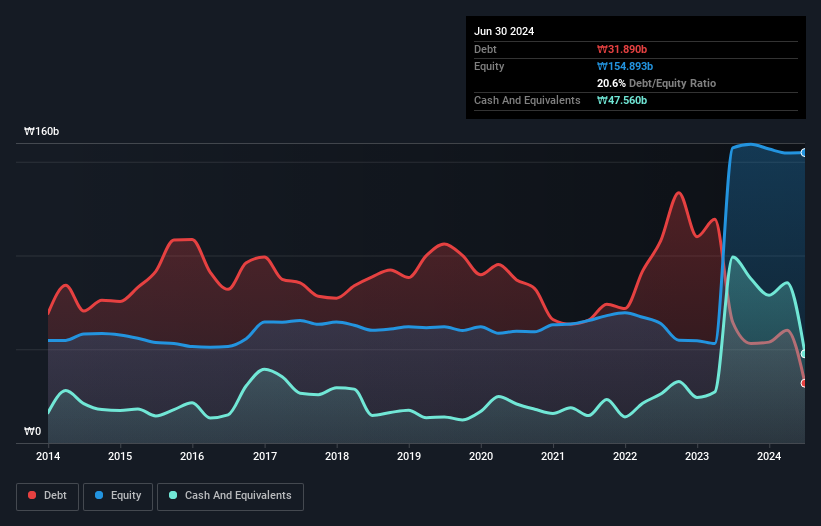
Legendary fund manager Li Lu (who Charlie Munger backed) once said, 'The biggest investment risk is not the volatility of prices, but whether you will suffer a permanent loss of capital.' When we think about how risky a company is, we always like to look at its use of debt, since debt overload can lead to ruin. We can see that Hanil Feed Co., Ltd. (KOSDAQ:005860) does use debt in its business. But should shareholders be worried about its use of debt?
When Is Debt A Problem?
Debt and other liabilities become risky for a business when it cannot easily fulfill those obligations, either with free cash flow or by raising capital at an attractive price. Part and parcel of capitalism is the process of 'creative destruction' where failed businesses are mercilessly liquidated by their bankers. However, a more usual (but still expensive) situation is where a company must dilute shareholders at a cheap share price simply to get debt under control. Having said that, the most common situation is where a company manages its debt reasonably well - and to its own advantage. When we examine debt levels, we first consider both cash and debt levels, together.
View our latest analysis for Hanil Feed
How Much Debt Does Hanil Feed Carry?
As you can see below, Hanil Feed had ₩31.9b of debt at June 2024, down from ₩64.4b a year prior. But it also has ₩47.6b in cash to offset that, meaning it has ₩15.7b net cash.

How Strong Is Hanil Feed's Balance Sheet?
The latest balance sheet data shows that Hanil Feed had liabilities of ₩41.6b due within a year, and liabilities of ₩9.33b falling due after that. On the other hand, it had cash of ₩47.6b and ₩19.2b worth of receivables due within a year. So it actually has ₩15.9b more liquid assets than total liabilities.
This surplus suggests that Hanil Feed has a conservative balance sheet, and could probably eliminate its debt without much difficulty. Simply put, the fact that Hanil Feed has more cash than debt is arguably a good indication that it can manage its debt safely.
We also note that Hanil Feed improved its EBIT from a last year's loss to a positive ₩2.7b. There's no doubt that we learn most about debt from the balance sheet. But you can't view debt in total isolation; since Hanil Feed will need earnings to service that debt. So when considering debt, it's definitely worth looking at the earnings trend. Click here for an interactive snapshot.
Finally, while the tax-man may adore accounting profits, lenders only accept cold hard cash. While Hanil Feed has net cash on its balance sheet, it's still worth taking a look at its ability to convert earnings before interest and tax (EBIT) to free cash flow, to help us understand how quickly it is building (or eroding) that cash balance. During the last year, Hanil Feed burned a lot of cash. While investors are no doubt expecting a reversal of that situation in due course, it clearly does mean its use of debt is more risky.
Summing Up
While we empathize with investors who find debt concerning, you should keep in mind that Hanil Feed has net cash of ₩15.7b, as well as more liquid assets than liabilities. So we don't have any problem with Hanil Feed's use of debt. There's no doubt that we learn most about debt from the balance sheet. However, not all investment risk resides within the balance sheet - far from it. Be aware that Hanil Feed is showing 1 warning sign in our investment analysis , you should know about...
If you're interested in investing in businesses that can grow profits without the burden of debt, then check out this free list of growing businesses that have net cash on the balance sheet.
Valuation is complex, but we're here to simplify it.
Discover if Hanil Feed might be undervalued or overvalued with our detailed analysis, featuring fair value estimates, potential risks, dividends, insider trades, and its financial condition.
Access Free AnalysisHave feedback on this article? Concerned about the content? Get in touch with us directly. Alternatively, email editorial-team (at) simplywallst.com.
This article by Simply Wall St is general in nature. We provide commentary based on historical data and analyst forecasts only using an unbiased methodology and our articles are not intended to be financial advice. It does not constitute a recommendation to buy or sell any stock, and does not take account of your objectives, or your financial situation. We aim to bring you long-term focused analysis driven by fundamental data. Note that our analysis may not factor in the latest price-sensitive company announcements or qualitative material. Simply Wall St has no position in any stocks mentioned.
About KOSDAQ:A005860
Excellent balance sheet with questionable track record.
Market Insights
Community Narratives



